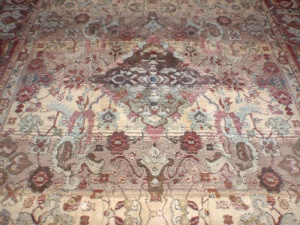Color Variations in Handmade Oriental Rugs
Posted on blog, carpet cleaning by dryconcepts
What is Abrash?
Authentic oriental rugs are handmade rather than machine-made, resulting in unique variations that set them apart from lesser reproductions. Handmade rugs naturally exhibit differences in surface coloration, density of hand-knotting, irregularities in shape along the edges, and variations in fringe ends.
One of the most recognizable characteristics of a real oriental rug is the beautiful color variation known as “abrash.” This feature is particularly common in older or nomadic rugs, creating diverse color patterns, gradations, and hues. Abrash often appears as horizontal bands or sections in shades of blue, red, brown, and other colors. These variations can range from subtle shade differences to bold, distinct color shifts.
Why Does Abrash Occur in Handmade Rugs?
Abrash results from differences in the hand-dyeing process, a technique that has been practiced for centuries. Unlike machine-made rugs, where colors are uniformly applied, handmade rugs rely on artisans who dye small quantities of yarn at a time. These dye batches are typically mixed and applied in different conditions, leading to subtle or sometimes noticeable variations in color.
Environmental factors such as water source, dyeing temperature, and drying methods can all contribute to these variations. Even using the same dye formula, the results may slightly differ from one batch to another. Additionally, the type of wool or fiber used, its natural oils, and how it absorbs the dye can influence the final coloration.
When a rug is woven over a period of months or even years, new batches of yarn are introduced, each carrying its unique hue due to these natural inconsistencies. These variations appear as abrash, which gives the rug a dynamic, artistic, and handmade aesthetic.
Collectors and connoisseurs of antique and semi-antique oriental rugs highly value the beauty of abrash, as it showcases the handmade craftsmanship and authenticity of the rug. Rather than diminishing its worth, abrash enhances a rug’s charm, ensuring no two rugs are exactly alike.
The Beauty of Abrash in Antique and Semi-Antique Rugs
Abrash is not considered a defect but rather a distinctive feature of handmade oriental rugs. It is a testament to the traditional methods used by skilled artisans who weave these rugs without the uniform precision of modern machinery. Some of the highest-quality machine-made rugs even attempt to replicate abrash to mimic the organic beauty of traditional craftsmanship. This unique coloration enhances the rug’s character, making it a highly desirable trait among rug enthusiasts and collectors.
How Cleaning Can Reveal Abrash in Rugs
Over time, soiling and rug pile compaction can obscure abrash color variations. Dust, dirt, and everyday wear dull the vibrancy of the rug’s original hues. Professional rug cleaning removes embedded dirt and restores the pile’s upright position, revealing the rug’s true coloration as it appeared when originally woven.
After a thorough cleaning, you may also notice:
-Enhanced abrash visibility as original colors reemerge.
-Slight shading variations due to differences in pile direction.
-A refreshed appearance that brings out the handmade beauty of the rug.
Abrash is a natural and beautiful characteristic of oriental rugs, and proper maintenance can help preserve its distinct charm for generations to come.
Is Abrash a Defect or a Feature?

Abrash is an inherent characteristic of genuine handmade rugs, not a flaw. Its presence signifies authenticity and adds to the unique appeal of oriental rugs. Even machine-made rugs attempt to replicate this natural variation to achieve an authentic aesthetic.
Preserve the Beauty of Your Rug with Professional Cleaning
If your handmade rug has lost its vibrant abrash coloration due to dirt accumulation, professional rug cleaning can restore its beauty. Our expert team at Dry Concepts specializes in preserving and enhancing the original colors of oriental rugs.


